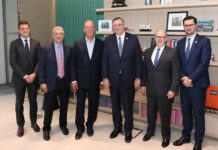DUBLIN--(BUSINESS WIRE)--The "Global Energy-Efficient Window Market Size, Share & Industry Trends Analysis Report By Application, By Component, By End-use, By Glazing Type, By Regional Outlook and Forecast, 2021-2027" report has been added to ResearchAndMarkets.com's offering.

The Global Energy-Efficient Window Market size is expected to reach $18.7 billion by 2027, rising at a market growth of 6.2% CAGR during the forecast period.
The adoption of the energy-efficient window, which decreases energy and air conditioning costs, is a major driver of the energy-efficient market industry's growth. Installing energy-efficient windows might help customers save up to 15% on overall annual air conditioning costs.
Moreover, increased demand for power, owing to population growth and rising dependency on electrical items, artificial air conditioning, as well as other energy-intensive devices, is expected to increase the need for energy-efficient devices. By closing off the air outlet from within the room, energy-efficient windows help to reduce electricity consumption waste.
As a result, it is easier to maintain the room's temperature and reduce the use of artificial air central heating, which fuels the development of the efficient energy windows business. Furthermore, governments have implemented rules to reduce home carbon footprints as a result of greater awareness about environmental preservation as a result of global recognition of climate change.
To put such measures in place, governments provide various subsidies for the replacement of aging furnaces and windows. Subsidies like these boost the economy for energy-efficient windows as replacements for older windows.
Market driving Factors:
Growing use of energy-efficient windows in the non-residential sector
Commercial buildings, such as workplaces, hospitals, hotels, airports, and educational institutions, are examples of non-residential structures that use energy-efficient windows. Major commercial buildings are constructed with energy conservation in mind. These structures are also designed to break even over time, so choosing energy-efficient windows appears to be a good choice.
In the commercial construction sector, with the developing economies tend to increase the demand for green buildings. Demand for such structures has recently increased in North American and European countries. The development of educational facilities and hospitals is expanding in developing nations, resulting in an increase in the demand for energy-efficient windows in the non-residential end-use sector.
Energy-efficient windows at a low cost
As compared to a less efficient choice, an efficient product is expense when the overall energy savings from prevented energy expenses during the product's life, discounted to present value, balance the additional up-front cost. When calculating required efficiency levels, ENERGY STAR reflects both upfront expenses as well as lifetime energy savings. ENERGY STAR-qualified items and products that fulfill FEMP-designated efficiency requirements can be assumed to be life cycle cost-effective by federal buyers.
Buyers that select products which exceed federal efficiency criteria may save more money in high-use scenarios or when energy prices are higher than the national average. In certain low-use applications or locations with very low electricity or natural gas rates, products achieving ENERGY STAR or FEMP-designated performance criteria may not be full-cycle cost-effective.
Marketing Restraining Factor:
Lack of awareness among consumers
Due to the strong development in the construction sector, the market for energy-efficient windows has a promising future. People in some undeveloped or underdeveloped countries in South America, Africa, and Asia are less conscious of the advantages of these window systems.
There is a lack of knowledge about building energy efficiency. This deters citizens in these countries from purchasing insulating products. When designing business and residential infrastructure in these countries, many engineers and architects disregard the building's energy efficiency. Awareness of Financial saving, can be achieved by constructing low-energy homes with energy-efficient window materials.
Key Market Players
- JELD-WEN Holding, Inc.
- PGT Innovations, Inc.
- Central Glass Co., Ltd.
- Apogee Enterprises, Inc.
- Saint-Gobain Group (CertainTeed)
- Asahi Kasei Corporation
- Schott AG (Carl-Zeiss-Stiftung)
- The YKK Group (YKK AP, Inc.)
- Nippon Sheet Glass Co., Ltd.
- Ply Gem Industries, Inc.
Scope of the Study
By Application
- Renovation & reconstruction
- New construction
By Component
- Glass
- Frames
By End-use
- Non-residential
- Residential
By Glazing Type
- Double Glazed
- Triple Glazed
- Others
By Geography
- North America
- US
- Canada
- Mexico
- Rest of North America
- Europe
- Germany
- UK
- France
- Russia
- Spain
- Italy
- Rest of Europe
- Asia Pacific
- China
- Japan
- India
- South Korea
- Singapore
- Malaysia
- Rest of Asia Pacific
- LAMEA
- Brazil
- Argentina
- UAE
- Saudi Arabia
- South Africa
- Nigeria
- Rest of LAMEA
For more information about this report visit https://www.researchandmarkets.com/r/ryvjss
Contacts
ResearchAndMarkets.com
Laura Wood, Senior Press Manager
press@researchandmarkets.com
For E.S.T. Office Hours Call 1-917-300-0470
For U.S./CAN Toll Free Call 1-800-526-8630
For GMT Office Hours Call +353-1-416-8900
e riproduzione totale o parziale in qualunque formato degli articoli presenti sul sito.















